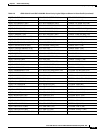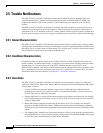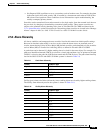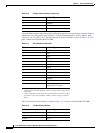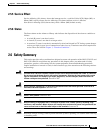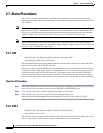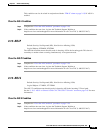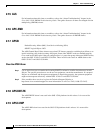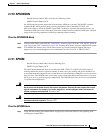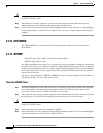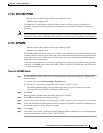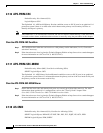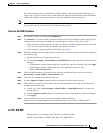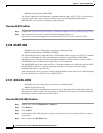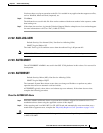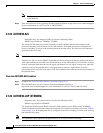
2-21
Cisco ONS 15310-CL and Cisco ONS 15310-MA Troubleshooting Guide, R7.0
Chapter 2 Alarm Troubleshooting
2.7.10 APSCINCON
2.7.10 APSCINCON
Default Severity: Minor (MN), Non-Service-Affecting (NSA)
SONET Logical Object: OCN
An APS Inconsistent alarm means that an inconsistent APS byte is present. The SONET overhead
contains K1/K2 APS bytes that notify receiving equipment, such as the ONS 15310-CL and
ONS 15310-MA, to switch the SONET signal from a working to a protect path when necessary. An
inconsistent APS code occurs when three consecutive frames contain nonidentical APS bytes, which in
turn give the receiving equipment conflicting commands about switching.
Clear the APSCINCON Alarm
Step 1 Look for other alarms, especially the “LOS (OCN)” alarm on page 2-98,or the “LOF (OCN)” alarm on
page 2-88 (or the “AIS” condition on page 2-18). Clearing these alarms clears the APSCINCON alarm.
Step 2 If an APSINCON alarm occurs with no other alarms, log into the Technical Support Website at
http://www.cisco.com/techsupport for more information or call Cisco TAC (1-800-553-2447).
2.7.11 APSCM
Default Severity: Major (MJ), Service-Affecting (SA)
SONET Logical Object: OCN
The APS Channel Mismatch alarm occurs when the ONS 15310-CL or ONS 15310-MA expects a
working channel but receives a protect channel. In many cases, the working and protect channels are
crossed and the protect channel is active. If the fibers are crossed and the working line is active, the alarm
does not occur. The APSCM alarm occurs only on the system when bidirectional protection is used on
OC-N ports in a 1+1 protection group configuration. The APSCM alarm does not occur in an optimized
1+1 protection configuration.
Warning
Invisible laser radiation could be emitted from the end of the unterminated fiber cable or connector.
Do not stare into the beam directly with optical instruments. Viewing the laser output with certain
optical instruments (for example, eye loupes, magnifiers, and microscopes) within a distance of
100 mm could pose an eye hazard.
Statement 1056
Warning
Use of controls, adjustments, or performing procedures other than those specified could result in
hazardous radiation exposure.
Statement 1057
Clear the APSCM Alarm
Step 1 Verify that the working-port channel fibers are physically connected directly to the adjoining node
working-port channel fibers.



